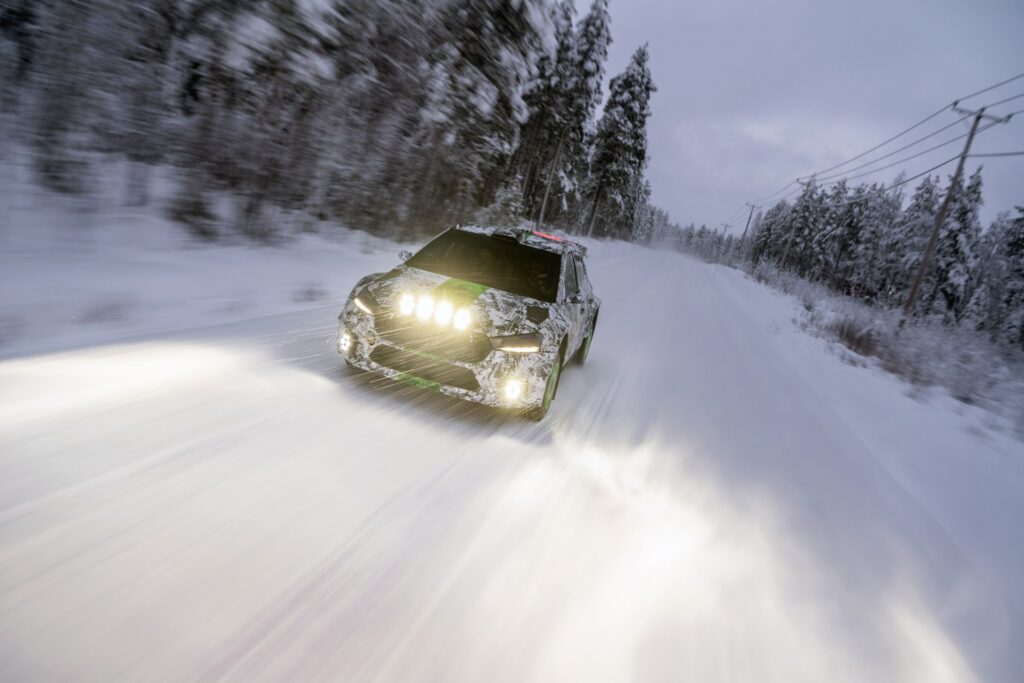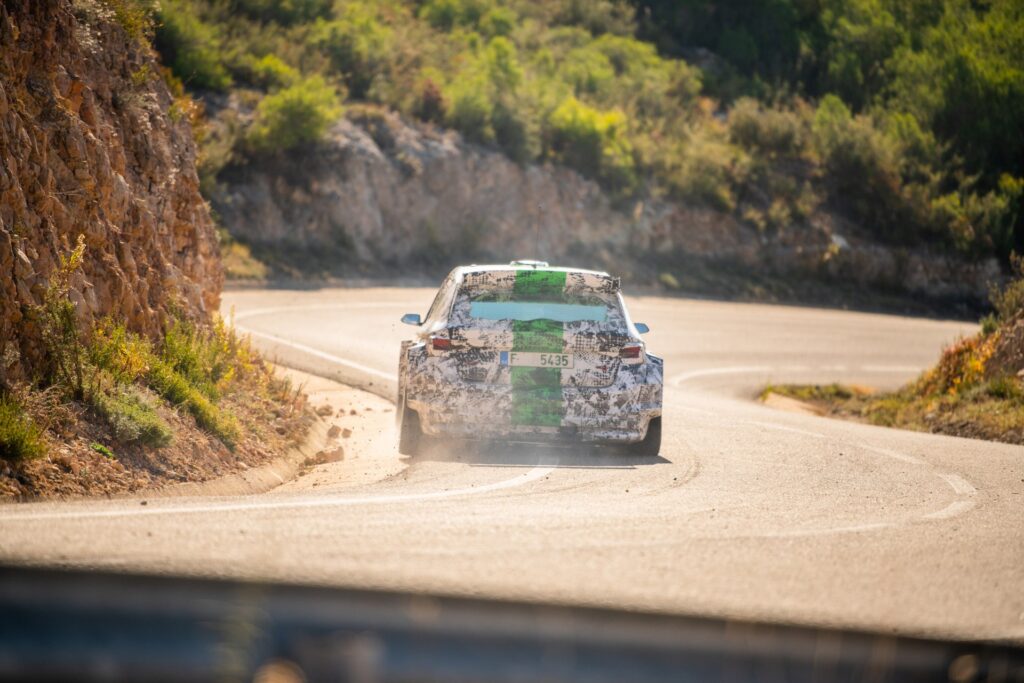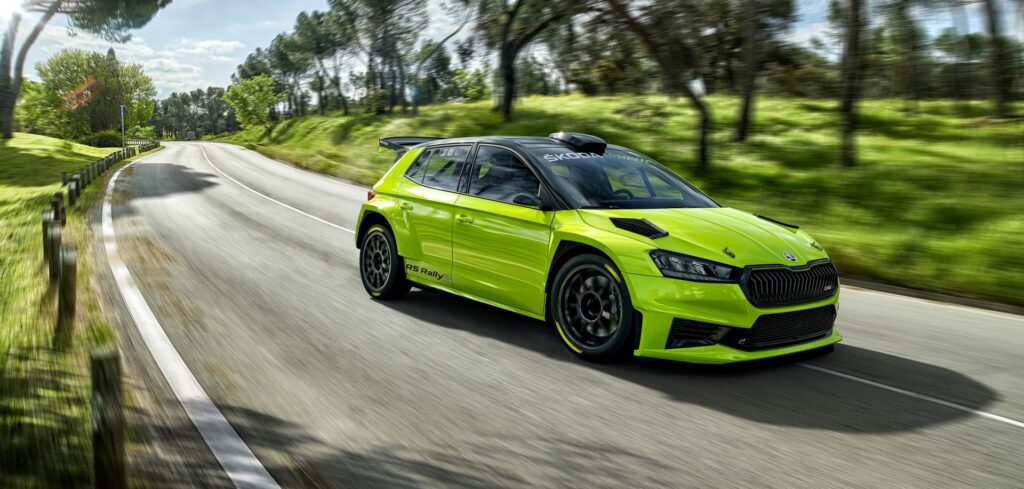Škoda’s Fabia Rally2 has secured its spot as one of the most successful R5 and latterly Rally2 machines on the market. Now, the Czech member of the VW Group is looking to repeat its long-running success with an all-new version, the Fabia RS Rally2.
Michal Hrabánek, head of Škoda Motorsport, said, “Standing still means going backwards, and this is especially true in motorsport. That’s why, in developing the new Fabia RS Rally2, we applied the experience we gained from the predecessor model and optimized every detail. The aim was to improve the most successful rally car in the world. I’m proud of the entire Škoda Motorsport team who have pursued this goal with great dedication. I would also like to thank our colleagues in Series Development; the fourth-generation Fabia provided us with a perfect basis for the Fabia RS Rally2.”
Based on the latest production version of the Fabia, which uses VW’s MQB-A0 platform, the Rally2 also features a newly developed 1.6-liter engine, built around VW’s ubiquitous EA888 2.0-liter unit. The new chassis enabled Škoda’s engineers to further optimize the rally car’s driving characteristics. It benefits from the longer wheelbase of the fourth-generation Fabia, apparently making the car quieter while ensuring a more stable rear. Compared to the outgoing model, the fuel tank has been repositioned and the additional space in the engine compartment has been used to accommodate a larger intercooler.
Power output is restricted to approximately 289bhp (214kW), thanks to the rules mandated 32mm restrictor, with a maximum torque of 309 lb-ft (430Nm). The engine has been further optimized over its predecessor with reworked inlet and exhaust ports, a revised combustion chamber, updated pistons, variable valve timing and a modified lubrication system. These changes, combined with a new turbocharger and the enlarged charge cooler, all contribute to greater performance and drivability.
Aero update
With Rally2 rules ensuring that cars stick closely to the architecture of their production variants, factors such as aerodynamic performance are reliant upon a sound base design. According to Škoda, the recently updated Fabia has provided an excellent starting point, meaning the Rally2 is considerably more potent aerodynamically than its predecessor.
“The aerodynamic elements used on the road car have proven to work in competition environment too and have given the aerodynamic package of the Škoda Fabia Rally2 an excellent foundation,” explained Lukáš Vojík, lead at Škoda Auto, Technical Development, Aerodynamics. “We gave aerodynamics even more attention than we already did [with the R5 Fabia] with the current rally car. The main development target was higher downforce, at the same time enhancing the overall aerodynamic efficiency of the car.”
Specific features of the road car, such as openings on both side ends of the front bumper, have been leveraged to benefit the rally machine. These so-called air curtains direct the air flow along the body’s side panels and wheel arches, reducing drag and aiding fuel efficiency on the road car. These features are mirrored on the rally car, working in conjunction with the front splitter, to achieve a similar aerodynamic efficiency gain.
The Rally2 Fabia also features a completely new rear wing and considerable attention has been paid to cleaning up airflow over the roof. The result, Vojík said, is “twice the downforce compared to the current rally car”.
Safety improvements
“The production Škoda Fabia’s new platform is made of high-strength and ultra-high-strength steel in areas critical for passenger safety. This is beneficial for the new generation Rally2 as well. It translates into further improved torsional strength of the floor structure and better durability of the rally car’s bodyshell,” explained Tomáš Karniš, safety engineer at Škoda Motorsport.
Since its debut in 2015, the previous generation Fabia, in both R5 and Rally2 trim, has proved its strength in accidents on special stages. “The analysis of these accidents gave us vital data to move the safety standards of the new generation even further. We aligned this data with other experience gathered with the current rally car and redefined the load cases for the new generation bodyshell,” said Karniš. Škoda’s engineers conducted multiple FEA analysis loops to refine the new design. “The calculations were followed by extensive testing on asphalt and gravel roads to validate the result of the simulation,” Karniš added.
 With the form of the roll cage (constructed from over 35m of chromoly tube) largely dictated by regulation, the next-gen car’s safety cell actually exceeds the FIA requirements in certain areas, Škoda notes. For example, the gussets providing resistance to side impact are significantly oversized compared to the FIA rules. “Our technicians apply an inventive way of building this part of the car: the safety cell is hand-welded by certified experts onto the bare platform during construction – before the side parts and the roof are added. This method guarantees higher accuracy as well as better tube connections and body shape copying,” said Karniš.
With the form of the roll cage (constructed from over 35m of chromoly tube) largely dictated by regulation, the next-gen car’s safety cell actually exceeds the FIA requirements in certain areas, Škoda notes. For example, the gussets providing resistance to side impact are significantly oversized compared to the FIA rules. “Our technicians apply an inventive way of building this part of the car: the safety cell is hand-welded by certified experts onto the bare platform during construction – before the side parts and the roof are added. This method guarantees higher accuracy as well as better tube connections and body shape copying,” said Karniš.
In addition to the oversized gussets, further steps have been taken to improve the side impact performance of the cage. Škoda Motorsport worked on three areas: seat mountings, roll cage door cross and door panels. For example, the left and the right side of the chassis are connected by the structure of the seat holders and an additional rail. Thus, the forces of a side impact are better transferred from one side of the car to the other. “This reduces deformation of the bodyshell and the roll cage. We surpass the FIA requirements also in this area,” commented Karniš. “The padding of the new generation also exceeds the FIA mandated volume in this area as well.”
Additionally, six layers of carbon fiber and Kevlar seal the foam in the direction of the cockpit to protect the crew from sharp fragments. The seatbelt mounting system has been improved as well. An additional roll cage tube on each side of the car has been added to increase the strength and stiffness of the shoulder strap mounting points.
One welcome side aspect of the further improved safety structure is increased durability of the bodyshell, which translates into reduced running costs for customer teams. “The durability of the newly developed bodyshell is on a different level compared to our current rally car,” Karniš said.




